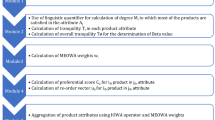Abstract
As an approach to search/retrieve such objects as pictures, music, perfumes and apparels on the Internet, sensitivity-vectors or kansei-vectors are useful since textual keywords are not sufficient to find objects that users want. The sensitivity-vector is an array of values. Each value indicates a degree of feeling or impression represented by a sensitivity word or kansei word. However, due to the gap between user’s subjective sensitivity (impression, image and feeling) degree and the corresponding value in the database. Also, such an approach is not enough to retrieve what users want. This paper proposes a retrieval method to automatically and dynamically reduce such gaps by estimating a subjective criterion deviation (we call “SCD”) using the user’s retrieval history and fuzzy modeling. Additionally, the proposed method can avoid users’ burden caused by conventional methods such as completing required questionnaires. This method can also reflect the dynamic change of user’s preference which cannot be accomplished by using questionnaires. For the evaluation, an experiment was performed by building and using a perfume retrieval system. Through observing the transition of the deviation reduction degree, it was clarified that the proposed method is effective. In the experiment, the machine could learn users’ subjective criteria deviation as well as its dynamic change caused by factors such as user’s preference, if the learning rate is well adjusted.





Similar content being viewed by others
Abbreviations
- SCD:
-
subjective criterion deviation
- SS-vector:
-
subjective sensitivity-vector
- NN:
-
Neural networks
References
Datta R, Joshi D, Li J, Wang JZ (2008) Image retrieval: Ideas, influences, and trends of the new age. ACM Comput Surv CSUR 40:1–60
Goldberg D, Nichols D, Oki BM, Terry D (1992) Using collaborative filtering to weave an information tapestry. Commun ACM 35:61–70
Hachimura K (1996) Retrieval of paintings by specifying impression words. Proceedings of the 19th annual international ACM SIGIR conference on Research and development in information retrieval, ACM, Zurich
Kato T, Honma SI, Matsuyama Y, Yoshino T, Hoshino Y (2009) Sensibility-aware image retrieval using computationally learned bases: RIM, JPG, J2K, and their mixtures. Proceedings of the 15th international conference on Advances in neuro-information processing—Volume Part I, Springer, Auckland
Kawai Y, Kumamoto T, Tanaka K (2006) User preference modeling based on interest and impressions for news portal site systems. Database and Expert Systems Applications, vol. 4080, Springer, Berlin, pp 549–559
Li L, Asano A, Asano CM (2008) Evaluation of Human Visual Impressions in Gray Scale Textures Using Morphological Manipulation. Proc. of Eighth International Conference on Hybrid Intelligent Systems (HIS’08), pp 114–119
Lie L, Liu D, Hong-Jiang Z (2006) Automatic mood detection and tracking of music audio signals. IEEE Trans Audio Speech Lang Process 14:5–18
Liu A, Zhang Y, Li J (2009) Personalized movie recommendation. Proceedings of the seventeen ACM international conference on Multimedia, ACM, Beijing
Myint EEP, Pwint M (2010) An approach for mulit-label music mood classification. Proc. of 2010 2nd International Conference on Signal Processing Systems (ICSPS), pp V1-290–V1-294
Nan-Ying L, Guang-Bin H, Saratchandran P, Sundararajan N (2006) A fast and accurate online sequential learning algorithm for feedforward networks. IEEE Trans Neural Netw 17:1411–1423
Ng W, Deng L, Lee DL (2007) Mining user preference using spy voting for search engine personalization. ACM Trans Internet Technol 7:19
Orio N (2006) Music retrieval: a tutorial and review. Found Trends Inf Retr 1:1–96
Sato N, Anse M, Tabe T (2007) A method for constructing a movie-selection support system based on Kansei engineering. Proceedings of the 2007 conference on Human interface: Part I, Springer, Beijing
Segaran T (2007) Programming collective intelligence : building smart web 2.0 applications, O’Reilly Media
Shen X, Tan B, Zhai C (2005) Implicit user modeling for personalized search. Proceedings of the 14th ACM international conference on Information and knowledge management, ACM, Bremen
Shirahama N, Yanaru T (1999) A KANSEI word processing system and personal adjustment. Proceedings of 1999 IEEE International Conference on Systems, Man, and Cybernetics (IEEE SMC’99), 6:269-272
Su X, Khoshgoftaar TM (2009) A survey of collaborative filtering techniques. Adv Artif Intell 2009:2–2
Sugihara T, Morimoto K, Kurokawa T (2004) An improved Kansei-based music retrieval system with a new distance in a Kansei space. Proc. of 13th IEEE International Workshop on Robot and Human Interactive Communication 2004, ROMAN, pp 141–146
Sutton RS, Barto AG (1998) Reinforcement learning: an introduction, MIT Press. ISBN 0-262-19398-1
Wong SKM, Yao YY (1995) On modeling information retrieval with probabilistic inference. ACM Trans Inf Syst TOIS 13:38–68
Yamakawa Y, Sasaki D (2007) Image search technique and action history in EC. Behaviormetric Soc Jpn 35:65–66
Ying H (2000) Fuzzy control and modeling : analytical foundations and applications, Wiley-IEEE Press
Yu Y, Joe K, Oria V, Moerchen F, Downie JS, Chen L (2009) Multi-version music search using acoustic feature union and exact soft mapping. IJSC 3(2):209–234
Acknowledgements
This work was supported by KAKENHI(21700244) and Research Center for Advanced Technologies of Tokyo Denki University.
Author information
Authors and Affiliations
Corresponding author
Rights and permissions
About this article
Cite this article
Sakurai, Y., Takada, K., Knauf, R. et al. A retrieval method adaptively reducing user’s subjective impression gap. Multimed Tools Appl 59, 25–40 (2012). https://doi.org/10.1007/s11042-010-0690-0
Published:
Issue Date:
DOI: https://doi.org/10.1007/s11042-010-0690-0




